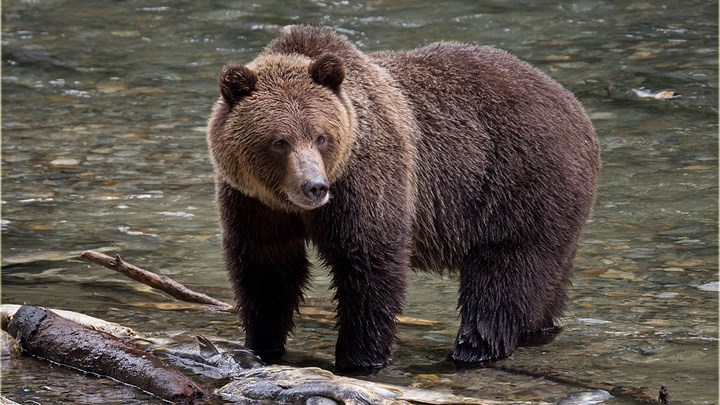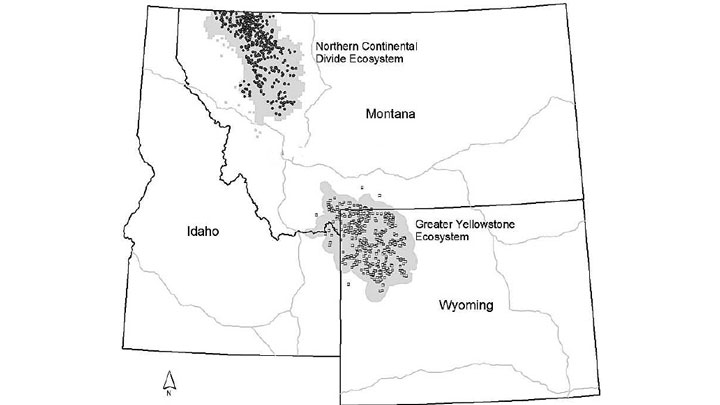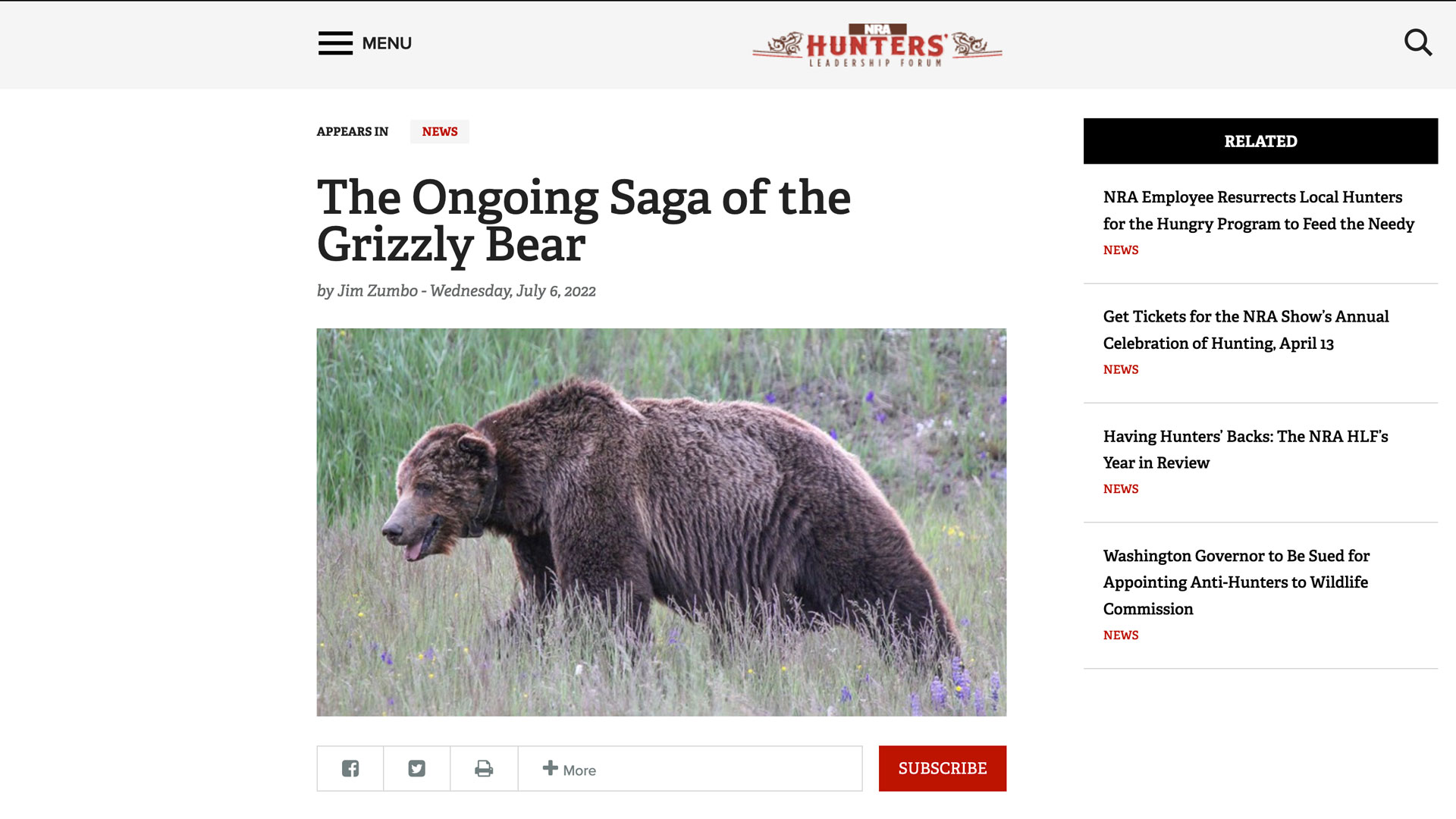
by Cody McLaughlin - Friday, March 17, 2023

The U.S. Fish and Wildlife Service (USFWS) has completed an initial review of three petitions filed to remove the grizzly bear from Endangered Species Act (ESA) protections in two separate ecosystems in the Lower 48. According to a USFWS press release, two of the petitions, filed separately by Governors Greg Gianforte of Montana and Mark Gordon of Wyoming, present substantial information showing that grizzly bears in the Northern Continental Divide Ecosystem (NCDE) and the Greater Yellowstone Ecosystem (GYE) may qualify as their own distinct population segments (DPS) and may warrant removal from the list of federally protected endangered and threatened wildlife species.

The USFWS’ next step is to launch a comprehensive status review of the grizzly bear in the NCDE and GYE using the best available scientific and commercial data to inform a 12-month finding. If findings lead to proposing one or more DPSs for delisting, entailing the return of management authority to the states, the USFWS “will consider them in the context of ongoing recovery efforts for the remainder of the population in the larger listed entity.”
Montana Gov. Gianforte’s petition was submitted to the USFWS for review in December 2021. It covers grizzly bears in the NCDE, which spans 16,000 square miles in northwest Montana. Wyoming Gov. Gordon’s petition was submitted in January 2022 and calls for delisting the bears in the Greater Yellowstone Ecosystem (GYE), which encompasses 34,375 square miles in northwestern Wyoming, southwestern Montana and eastern Idaho, the core of which is Yellowstone National Park. (The USFWS set aside the third petition, a broad-based request from Idaho Gov. Brad Little and the Idaho Department of Fish and Game to delist the species throughout the Lower 48, saying it “does not present substantial, credible information to warrant further action” at this time.
“After decades of work, the grizzly bear has more than recovered in the NCDE, which represents a conservation success,” said Gov. Gianforte, following the USFWS announcement. “As part of that conservation success, the federal government has accepted our petition to delist the grizzly in the NCDE, opening the door to state management of this iconic American species.”
Addressing issues with grizzly bear populations in the 22-million-acre GYE, Gov. Gordon thanked the USFWS and called the announcement a positive step.
“Wyoming’s petition, filed early last year, shows that—after 46 years, and over $52 million of investment by Wyoming sportsmen and women—the population of the bear is far above long-established recovery goals,” said Gov. Gordon. “Wyoming has an established framework to provide adequate protection and management of the bear in the future. I trust the FWS will continue to use the best scientific evidence, and I hope that Wyoming will soon manage this species as part of our treasured wildlife populations.” Gordon added that Wyoming’s current grizzly bear management plan would be amended to recognize the necessary legal requirements to satisfy ESA requirements for post-delisting management.
While there can be no doubting the iconic nature of the western grizzly bear populations of the Northern Rockies—something that extremist and conservation groups agree on to be sure—the differences of opinion quickly become heated when the discussion comes to long-term goals for the species. If the goal of the Endangered Species Act (ESA) is truly to recover species to a level where they no longer require federal protection, then it is incumbent upon wildlife managers at the state and federal levels to move past the “charismatic megafauna” trope and acknowledge and admit success. This is critical so we not only can continue to properly manage the species itself, but so that further resources aren’t dedicated to a species that has recovered and no longer needs the intensity of oversight that other truly-ESA-qualified species desperately need.
Anti-hunting extremist organizations have for years touted unfounded concerns that delisting the grizzly bear could lead to threats to their population due to the increase in legal, regulated hunting, something that has never in the history of the Federal Aid in Wildlife Restoration Act of 1937—commonly referred to as the Pittman Robertson Act (P-R)— contributed to the extinction of a species. Those same groups argue, in the face of overwhelming evidence to the contrary and a mathematical model showing populations at or above current carrying capacity, that grizzly bears are still vulnerable and that “more time and effort is needed to ensure their long-term survival.”

This threat and the deep-pocketed and highly litigious nature of animal rights extremist groups all but guarantees the possibility of legal challenges even after delisting as we have already seen.Delisting would bring about more court battles in the future as self-serving groups attempt to grab money from wildlife agencies through constant lawsuits and blatant small-dollar fundraising drives.
In the case of a favorable status review where the USFWS determines that NCDE and GYE grizzly bear populations no longer meet the criteria for listing under the ESA, the agency will publish a proposed rule in the Federal Register to seek comments from other federal agencies, state wildlife biologists, independent species experts and the public. After analyzing comments, the USFWS will announce its final decision in the Federal Register at which time it will either delist the bears or withdraw the action to maintain the species’ current status. If the grizzly bear populations in the two ecosystems are delisted, the ESA requires the USFWS, in cooperation with the states, to monitor them for at least five years to assess their ability to sustain themselves in the absence of ESA protections.
Should grizzly bear management authority be returned to the state fish and wildlife agencies—long recognized as the primary and most effective managers of fish and wildlife in the United States—the bears would be managed in the context of local conditions, ensuring the implementation of programs that best support the species’ long-term health and sustainability. This also would provide greater flexibility when it comes to initiating programs that reduce human-bear conflicts and deadly attacks by the bears on humans and mitigate the impacts of habitat loss and fragmentation. With state agencies in charge of management, they can develop more nuanced and context-specific strategies that consider local socio-economic factors and the needs of local communities.
Be sure to check back with this NRA Hunters’ Leadership Forum website and with the NRA Institute for Legislative Action website (NRAILA.org) as we continue to watch and report on what comes next.
Editor’s Note
Marking its 50-year anniversary, the Endangered Species Act (ESA) continues to prevent the extinction of imperiled species, promoting the recovery of wildlife and conserving the habitats upon which they depend. The ESA has been credited with saving 99 percent of listed species from extinction. According to the Department of the Interior, more than 100 species of plants and animals have been delisted based on recovery or reclassified from endangered to threatened based on improved conservation status. Hundreds more species are stable or improving, thanks to the collaborative actions of tribes, federal agencies, state and local governments, conservation organizations and private citizens.—KMP
About the Author
Cody McLaughlin is a conservationist and conservative thought leader on public policy issues including hunting, fishing, gun rights, free-market tax and wage policy and the environment. He works as a GOP consultant for conservative political causes, managing clients’ digital communications and online presence, serves currently on the board of the Alaska Outdoor Council (the Last Frontier’s state NRA Affiliate) and is a former board member and lead spokesman of the New Jersey Outdoor Alliance, helping to represent the state’s 1.2 million sportsmen in the political arena.
E-mail your comments/questions about this site to:
[email protected]
Proudly supported by The NRA Foundation and Friends of NRA fundraising.
